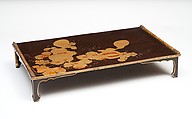Writing Table (Bundai) with Melons and Squirrels
Not on view
This writing table, which was probably originally made as a set with a matching writing box, is decorated with designs of melons and squirrels, auspicious symbols representing good fortune and fertility. This painterly subject originates from Chinese compositions depicting nature, including birds and flowers, grasses, vegetables, and insects, popular in the arts of the Ming dynasty. Painters in Japan during the Muromachi period (1392–1573) incorporated these subjects into their repertory. The maki-e artist depicted the squirrels in a dynamic, playful composition, while some of the leaves are designed as if partially eaten by insects. The application of the flat maki-e and the e-nashiji (“pearskin picture”) sprinkling follows the Momoyama-period traditions (1573–1615) of Kōdaiji lacquers.
Due to rights restrictions, this image cannot be enlarged, viewed at full screen, or downloaded.

